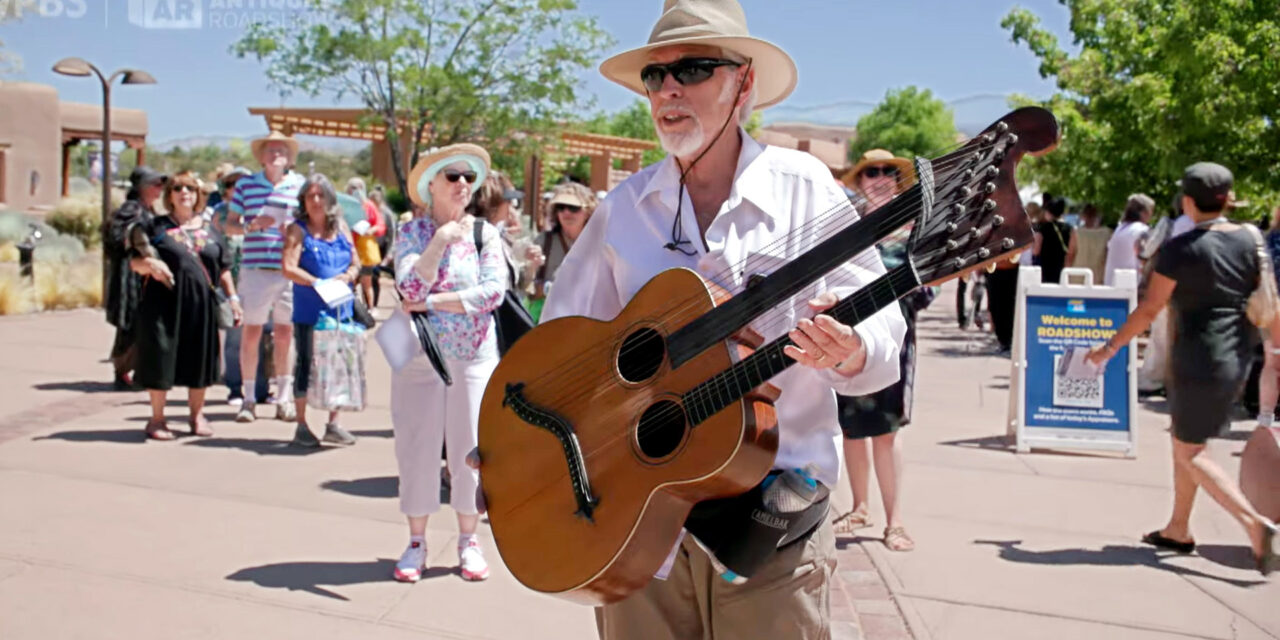
This one is fascinating!
My harp guitar pal Frank Doucette texted me a couple nights ago, alerting me to watch that night’s episode of Antiques Roadshow (he had just seen it on the East Coast and it was soon to air here in California). He teased that they showed a harp guitar that was “cool” and “not in the Harpguitars.net Encyclopedia of Historical Makers.”
He was right on both counts. The episode – filmed in Santa Fe, New Mexico on Museum Hill – aired on Jan 23, 2023. The owner may or may not have been local. It appears here at 27:59. Unfortunately, the instrument was not one of those treasures that warranted a full appraisal, but only a quick cut to a guy standing in line with it. That means we can’t get the appraiser’s name in order to request info. (If anyone has a contact at the show, please help try to track this down!)

As the screen grabs from the PBS web site show, it was only identified as a “Carlotti harp guitar, ca. 1900,” with a pretty lame estimate. At least they got the date close. As for “Carlotti,” he indeed might have been a one-off maker if a label was present, and this Carlotti was especially skilled. Photoshop enhancing the images, I see zero evidence of a label. My suspicion is that perhaps the owner’s name was Carlotti, and that’s the only info the owner (his grandson) had…and the only thing the appraiser had to give it a name. Note that the grandson said his grandfather played it – no mention of building it. (He also may or may not have been the original owner. In fact, the 1890s when I think it was built seem more of a great-grandfather’s generation.) I’m hoping in posting this that the owner might stumble across this article someday and provide more information.

So, then, what is it? As I said – fascinating. In that it looks like a cross between my Jenkins Harwood and Weymann harp guitars!
Theory #1 is that someone named Carlotti had access to one of each in order to expertly combine their features and build this similar instrument. I don’t believe that happened here. Unless he was a luthier employed by one of those two manufacturers?
Theory #2 is that the name “Carlotti” was indeed seen somewhere inside the instrument and was a repairman’s label/inscription. Which brings us right back to “who made it?”
Theory #3 of a Jenkins “Harwood” brand instrument is unlikely, in that there is no white “Harwood” fretboard marker (which they all had), nor is the head an exact match, while the bridge is wrong.
Ah, that bridge! And so I believe it’s Theory #4 – an early experimental or custom 1890s Weymann patterned after the unique Harwood which had already been in production for some time.
Let’s compare:

My (attributed to) Weymann HG is on the left, my Harwood is on the right. Both were built in the late 1890s. Both are huge instruments with a full twelve sub-basses and Brazilian rosewood sides and backs. The Harwood is all-original, the Weymann has a replacement bridge by Kerry Char modeled after one from a nearly-identical specimen. It features a severe slope down for the subs with that delightful arrow tip. Surprisingly, the right edge of the bridge is left square.
In our mystery instrument, the shape of the bridge appears halfway between that of the Harwood and Weymann, with the builder presumably inspired by the Harwood’s fancy bridge ends. These are an exact match to the Weymann’s single decorative end.
As for the head, Harwoods (of which several are known) all have a scalloped head for the main neck and a routed scroll for the sub-bass piece. The “Carlotti” is plain. It doesn’t resemble the Weymann, but as I said, I think they were copying a Harwood (and possibly only from an image). The sub-bass nut, on the other hand, is a perfect match to the Weymann, as it juts out gracefully, unlike the simpler Harwood. It shares the full twelve (chromatic) subs of both instruments and their friction tuners for all eighteen strings. The twin dovetailed “necks” are similar in all three instruments.
Again, the unique double soundholes were clearly copied from the Harwood, though not their placement in the body, which is a new shape. It’s chunkier than the Harwood, with the waist intersecting the lower portion of the holes like the Weymann rather than just below them as in the Harwood. Note that the Harwood’s neck joins the body at the tenth fret rather than the 12th.
The sides on this one appear to be mahogany, and the soundhole rings are simple (small herringbone, or just b&w rings?).
It has two simple dot fretboard markers at the 7th and 9th fret. Most makers (including Jenkins for the Harwoods) put a dot at the 10th fret, while Weymann guitars have them at the ninth, as in this recently discovered (labeled) Weymann below.
Whatever it is, what a wonderful and intriguing find! Any other thoughts on this, please leave a comment.
For those new to the Harwood or Weymann instruments, my exhaustive research on those is here:






